Revisiting Linux GPUs: Playing the Driver Game
by Kristopher Kubicki on December 17, 2004 12:49 AM EST- Posted in
- Linux
>Unreal Tournament 2004 32-bit Linux
Unreal Tournament has the unique advantage of being a 64-bit and a 32-bit benchmark. We will use the 3334 demo binaries here - the 3339 demo was installed, but provided no performance benefits. We stayed with the 3334 binaries so that the previous analysis benchmarks were still relevant. Don't forget to check out our previous analysis here.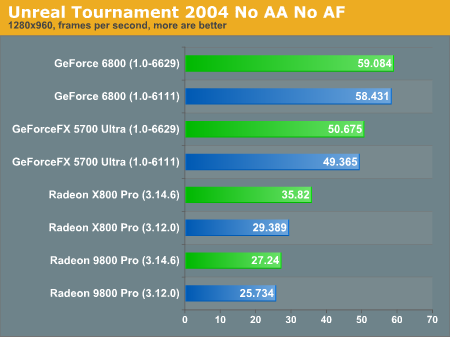
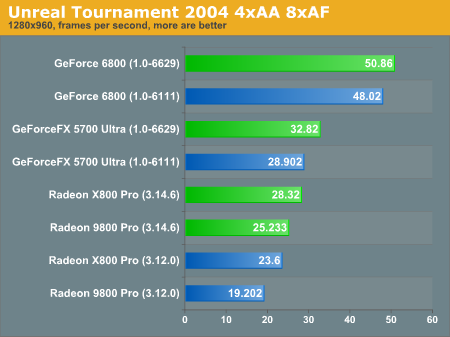
Things pretty much replicate what we saw in the Wolfenstein benchmark - small to moderate performance gains by both cards with ATI looking at a lot of ground to catch up on. Below, you can see a portion of the Unreal Tournament 2004 "assault" benchmark.
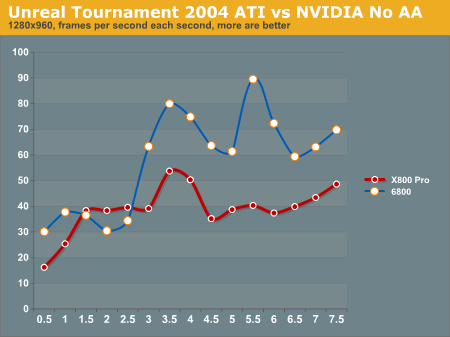
Also, you can see what affect the new driver set had on this same timeframe (the CSV file is available for download here.
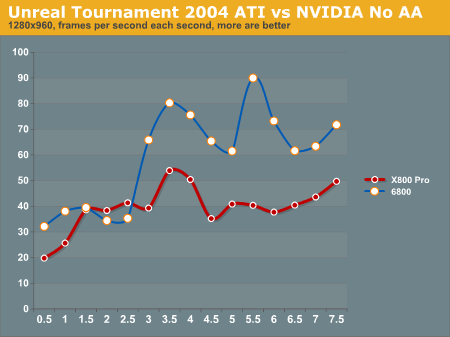
Pay very close attention to the local maxima and minima. Comparing the second graph with the first, and not just the two cards against each other, reveals that both cards received some serious gains in performance without losing a step. NVIDIA's performance is very rapidly approaching the Windows performance, and we wouldn't be surprised if NVIDIA could actually pull off symmetric performance on its Linux and Windows platforms should the next few driver updates provide this sort of a performance gain.
Unreal Tournament 2004 64-bit Linux
As we mentioned before, we are limited to NVIDIA graphics cards for this portion of the test - there are no 64-bit ATI drivers yet. Here is a quick and dirty comparison of the two driver sets on the video cards that we selected for this analysis. The first graph shows the 32-binaries running on the 64-bit kernel. The second graph shows the 64-bit binaries running on the 64-bit kernel.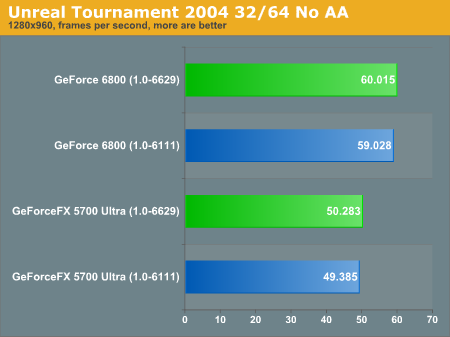
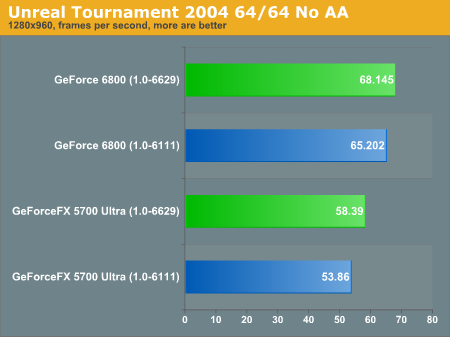
As expected, we noticed virtually no difference between the 32-bit binaries on the 32-bit kernel or 64-bit kernel. We see an occasional single FPS bump on the higher end cards, but there really isn't much advantage to running the 32-bit binaries on the 64-bit world. The 64-bit binaries yield better results, although there is nothing really outstanding about the performance gains going from the 32-bit binaries to the 64 ones, or going from the August driver set to the November one.










23 Comments
View All Comments
DarkTrooper - Tuesday, December 6, 2005 - link
First the good part, I am glad that ATI has finally managed to get a good working installer. Now the bad part for me: since I switcht to an x850 (R481 Core) I cant use the Driver, since it seems that the specifiy PCI-ID is not in this driver, which results in an "no matching pci ID found" after running fglrxconfig (which would be nice to have in a GUI version, or at least a menue based text version). Hope they manage to add this product soon... gets kind of anoying always having to wait month over month until they manage to fix things like this. Also the missing 64bit driver is some what disapointing (even though I only own 32Bit maschines).mpineiro - Thursday, May 5, 2005 - link
While I will admit that I only skimmed through the article, I think you failed to mention that it is nearly impossible to install the ATI drivers, especially with 3d Acceleration on most distributions.momenman - Friday, December 31, 2004 - link
Though the statements here regarding NVIDIA is generically true - I am personally unhappy with the "mouse moves but screen frozen" bug - due to which I can't use the 3D acceleration on FX-5700 ( though the problem is not there with GeForce2 MX cards, for example. ) . Its been almost a year and half since this bug surfaced on the nvidia linux board but the problem persists - thanks to the closed nature of the nvidia drivers.Let's just wait and see .....
svartalf - Sunday, December 19, 2004 - link
In regards to the DRI project drivers "not being there", I will offer that you've been trying the official released drivers that are typically included with the distributions. (By the way, you can _almost_ play UT 2k4 with the drivers- I know, I recently tried it on a Centrino based laptop and an r200 based GPU.) Recent improvements include 3D accel across Xinerama screens and TCL support- these are betas in the version control system and should be showing shortly in the distributions as they're wrung out.SLIM - Saturday, December 18, 2004 - link
You can add one more dissenting opinion to the growing list in regard to the comment about 64/64 being a meager boost compared to 32/32 UT2004. A 15% boost in performance is better than a processor upgrade, some vid card upgrades and certainly better than anything expensive ram can do compared to value ram (2-2-2 vs 3-3-3 @400). I just hope 64bit windows will be able to show the same level of performance gains.Saist - Friday, December 17, 2004 - link
I'm just going to say this to the author:try to install ATi drivers into Debian.
if you get that to succeed. Please do an article on how you did it.
Rand - Friday, December 17, 2004 - link
I'm inclined to agree with the opinions of thoe others, I felt the relative gains from going to 64bitwas quite appreciable.At this point I'm not sure I would even have expected the ~10% gain seen, so it's quite decent from my perspctive.
ATI's performance under Linux still remains wholly unimpressive at best. Seeing the less then impressive 5700U beating the X800 Pro in a number of cases only serves to underline how poorly ATI's drivers perform.
It doesn't impact me personally as I rarely use Linux and not at all for gaming, but for those that do nVidia is still clearly the manufacturer of choice.
mlittl3 - Friday, December 17, 2004 - link
Oh and one other thing.Intel said that going from 32 to 64 bits will just allow one to add (address) more than 4 GBs of RAM to a system and that's all.
AMD always said that the added registers would allow for improvements no matter how much RAM you have.
I guess AMD was right.
PS. How much improvement is necessary to go from meager to the next level? The way I see if from the article it's something like this.
0-10% Abysmal
10-20% Meager
20-30% Poor
30-40% Average
40-50% Good
50%> Excellent
I don't think we will ever see a greater than 30% increase going from 32 to 64 bit in order to get a positive rating, but hey, some people are harder to please than others.
mlittl3 - Friday, December 17, 2004 - link
I have to agree also with #5,8,10. I must not know what the definition of "meager" is. Any improvement over 10% is totally significant by any measurement.Just looking back at an old Anandtech article comparing Unreal 32 to 64 bit performance in SuSe 9.1 shows 32bit performance at 26 fps and 64bit at 25 fps. Now a 1fps difference is meager and shows 32bit winning over 64bit.
http://www.anandtech.com/linux/showdoc.aspx?i=2114...
I know this was a very different system but the absolute frame rate is not what's important. Its the difference between 64bit vs. 32bit. Driver development has come a long way and now we are seeing a 13 to 15% increase in fps going from 32 to 64bit.
And you can't say that its just the drivers because the same drivers are being used in 32 and 64 bit modes in this new comparison and we are still seeing a "huge" (not meager) gain in performance going from 32 to 64bit.
Framing articles in reference to old data is a good way to measure improvements. I think that is how we know if an older video card is outperformed by a newer one, a new operating system works better than an older, etc.
deathwalker - Friday, December 17, 2004 - link
yawwnnn!!!!